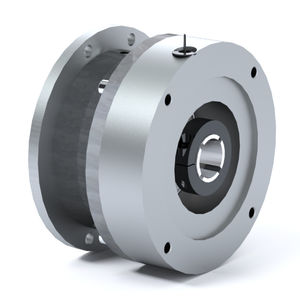
- Company
- Products
- Catalogs
- News & Trends
- Exhibitions
Centrifugal brake DBQmechanicalsafetyflange-mounted






Add to favorites
Compare this product
Characteristics
- Type
- centrifugal
- Operation
- mechanical
- Other characteristics
- safety, flange-mounted, shaft-mounted, for motors
- Torque
21 Nm, 23 Nm, 35 Nm, 45 Nm
(15.4888 ft.lb, 16.9639 ft.lb, 25.8147 ft.lb, 33.1903 ft.lb)
Description
The centrifugal brake DBQ, has as its main function to limit the lowering speed in case of motor failure.
They work by action of centrifugal force, without additional external power, this makes them suitable for security applications.
The DBQ centrifugal brake is designed to be mounted between motor and gearbox with standardized IEC B5 flanges and for speeds of 1500rpm or 1800 rpm.
The main characteristic of this centrifugal brake is that it can be disabled at will. In a quick and easy way.
At the time when it is necessary to test with the FPC parachute safety brake, which is installed on the same machine and acts at a higher speed. It is quickly disabled, the test is performed, and it will be re-enabled once the test is complete.
In this way we will be able to have two brakes to achieve maximum safety and at the same time test them without having to uninstall the DBQ centrifugal brake.
Both the locking brake and the centrifugal brake cannot prevent the accident if the abnormality occurs in the reducer or any element after them.
Characteristics:
Individual or self-supporting group.
Standard flanges and shafts.
High protection.
The DBQ Centrifugal Brake can be used for different types of machinery such as:
Renewable Energy Machines
Building and facade cleaning machines
Machine tool
Construction sector machines
VIDEO
Catalogs
Related Searches
- Flexible shaft coupling
- Shafts coupling
- Friction brake
- Spring brake
- Disc brake
- Electromagnetic brake
- Friction clutch
- Sleeve shaft coupling
- Hydraulic brake
- Overload clutch
- Electromagnetic clutch
- Safety brake
- Misalignment correction shaft coupling
- Pneumatic brake
- Maintenance-free shaft coupling
- Spring activated brake
- Disc clutch
- Emergency brake
- Machines coupling
- Torsionally rigid shaft coupling
*Prices are pre-tax. They exclude delivery charges and customs duties and do not include additional charges for installation or activation options. Prices are indicative only and may vary by country, with changes to the cost of raw materials and exchange rates.







